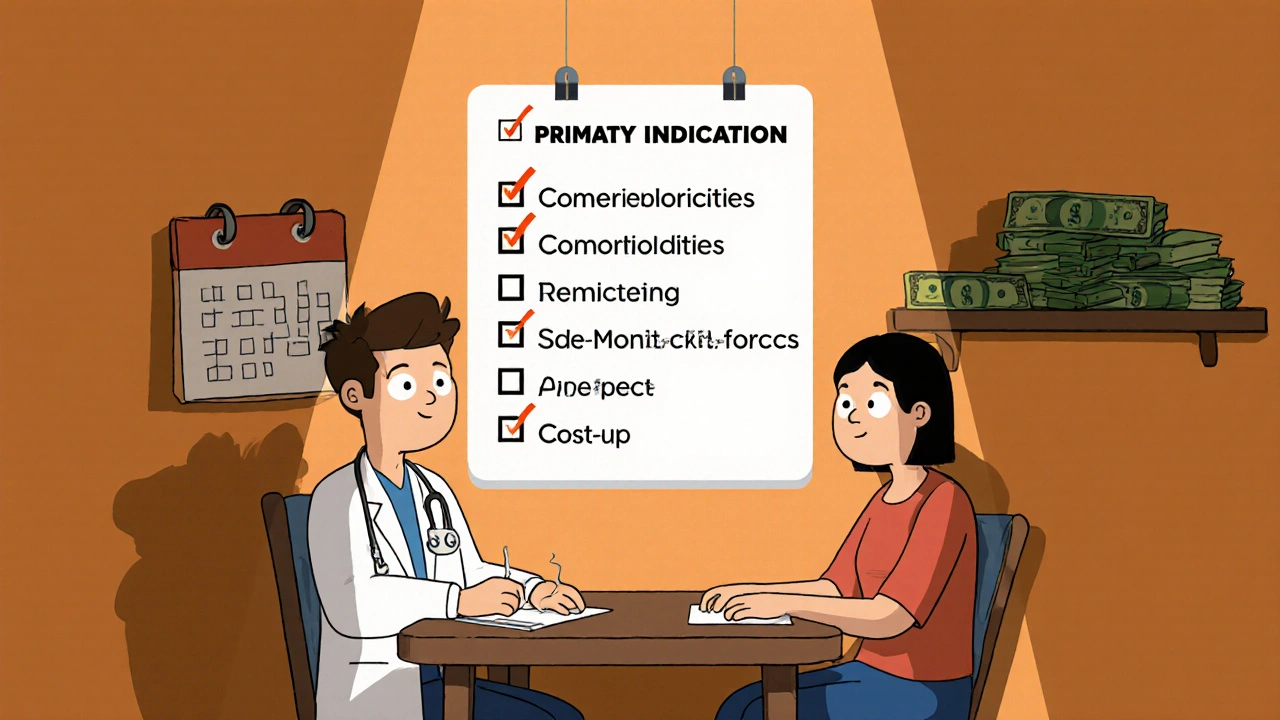 Oct, 26 2025
Oct, 26 2025
Prazosin vs Alternatives Decision Guide
Find Your Best Match
Answer a few questions about your health conditions and priorities to see which medication might be most appropriate for you.
Prazosin is an oral alpha‑1 adrenergic blocker originally approved for hypertension but widely used to relieve urinary symptoms caused by benign prostatic hyperplasia (BPH). It works by relaxing smooth muscle in blood vessels and the prostate, lowering blood pressure and easing urinary flow. While it remains a solid option, clinicians and patients often wonder whether newer or cheaper drugs might do a better job. This guide walks through how Prazosin stacks up against the most common alternatives, highlighting efficacy, side‑effect profiles, dosing quirks, and best‑fit scenarios.
How Prazosin Works and When It’s Prescribed
When you take Prazosin, it blocks the alpha‑1 receptors on vascular smooth muscle. The result is vasodilation, which drops systolic and diastolic pressures by about 10‑15 mmHg in most adults. For BPH, the same blockade eases the tension in the prostate and bladder neck, reducing nighttime urination and stream weakness.
- Typical dose for hypertension: 1 mg at bedtime, titrated up to 5 mg daily.
- Typical dose for BPH: 1 mg at bedtime, sometimes increased to 2 mg.
- Onset: Blood‑pressure effect starts within 30 minutes; urinary relief may take 2‑4 weeks.
Because it’s short‑acting, a steady‑state level requires dosing once daily at night, which can cause a “first‑dose” drop in blood pressure-often felt as dizziness or light‑headedness when standing.
Key Factors When Choosing a Blood‑Pressure or BPH Drug
Before you compare pills side‑by‑side, think about what matters most to the patient and the prescriber.
- Efficacy: Does the drug lower blood pressure enough, or resolve urinary symptoms quickly?
- Side‑effect profile: Orthostatic hypotension, fatigue, sexual dysfunction, or metabolic changes?
- Comorbid conditions: Diabetes, heart failure, or prostate cancer may sway the choice.
- Cost & insurance coverage: Generic availability can mean big savings.
- Drug interactions: Some agents amplify the effect of other antihypertensives.
With those lenses, let’s meet the most frequently considered alternatives.
Alternative Medications Overview
Below is a quick snapshot of five drugs that often appear in the same therapeutic arena as Prazosin. Each has its own strengths and trade‑offs.
- Doxazosin - another long‑acting alpha‑1 blocker, approved for both hypertension and BPH. It’s taken once daily and tends to cause less pronounced first‑dose hypotension.
- Terazosin - similar to doxazosin but with a slightly longer half‑life. Often preferred for patients who need steady blood‑pressure control over 24 hours.
- Atenolol - a beta‑blocker that works by slowing heart rate and reducing cardiac output. It’s a solid choice when anxiety‑related tachycardia co‑exists with hypertension.
- Labetalol - a combined alpha‑ and beta‑blocker, useful in patients with both high blood pressure and a need for heart‑rate control, such as those with angina.
- Hydrochlorothiazide - a thiazide diuretic that reduces blood volume. Often paired with other agents for resistant hypertension.

Side‑Effect Profiles at a Glance
| Drug | Typical Side‑Effects | Notable Risks |
|---|---|---|
| Prazosin | Dizziness, headache, fatigue, nasal congestion | First‑dose orthostatic hypotension |
| Doxazosin | Dizziness, edema, nasal congestion | Less severe first‑dose drop, possible fluid retention |
| Terazosin | Dizziness, fatigue, sexual dysfunction | Longer half‑life may cause lingering hypotension |
| Atenolol | Bradycardia, cold extremities, fatigue | Masking hypoglycemia symptoms in diabetics |
| Labetalol | Dizziness, nausea, bronchospasm (in asthmatics) | Potential for severe hypotension when combined with other blockers |
| Hydrochlorothiazide | Increased urination, electrolyte imbalance, gout flare | Risk of hypokalemia and glucose intolerance |
When Prazosin Is the Right Choice
If a patient needs both blood‑pressure control and relief from BPH symptoms, Prazosin is often the simplest single‑pill solution. It works quickly for hypertension and, after a few weeks, eases nighttime urination. Ideal candidates include:
- Men under 70 with mild‑to‑moderate BPH and stage‑1 hypertension.
- Patients who tolerate nocturnal dosing and can manage the first‑dose dip by starting at a low 0.5 mg dose.
- Those who prefer an inexpensive generic with a well‑established safety record.

When Alternatives May Outshine Prazosin
Even a solid drug like Prazosin has limits. Consider the following switches:
- Doxazosin or Terazosin: If a patient experiences troublesome first‑dose dizziness, the longer‑acting alpha‑blockers provide smoother blood‑pressure curves.
- Atenolol: When anxiety or tachyarrhythmia co‑exists with hypertension, a beta‑blocker adds heart‑rate control.
- Labetalol: In patients with concurrent angina or heart failure, the dual alpha‑beta blockade can be more protective.
- Hydrochlorothiazide: For resistant hypertension where volume overload is a factor, a thiazide diuretic often synergizes with an alpha‑blocker.
Practical Checklist for Clinicians and Patients
Use this short list as a decision aid during the consultation.
- Confirm the primary indication - pure hypertension, BPH, or both.
- Review comorbidities: diabetes, asthma, heart failure, gout.
- Start low, go slow: e.g., 0.5 mg prazosin at bedtime, titrate weekly.
- Monitor blood pressure and post‑void residual volume after 2‑4 weeks.
- Educate about first‑dose dizziness - advise standing up slowly.
- Re‑evaluate cost and insurance coverage; switch to a longer‑acting alpha‑blocker if adherence suffers.
- Document side‑effects in the chart; be ready to substitute if sexual dysfunction becomes problematic.
Frequently Asked Questions
Can Prazosin be used alone for BPH?
Yes. While it was originally an antihypertensive, many urologists prescribe it as a single agent for mild‑to‑moderate BPH, especially when the patient also has elevated blood pressure.
Why does the first dose of Prazosin cause dizziness?
Prazosin peaks quickly after oral intake, causing a sudden drop in vascular resistance. Taking it at night and starting with half the usual dose blunts the effect.
How does Prazosin compare to Doxazosin for hypertension?
Both lower systolic pressure by ~10 mmHg, but Doxazosin’s longer half‑life yields steadier control and fewer first‑dose symptoms. However, Doxazosin is usually more expensive and may cause fluid retention.
Is it safe to combine Prazosin with a thiazide diuretic?
Combining them is common for resistant hypertension. Monitor electrolytes and blood pressure closely, as the duo can amplify the hypotensive effect.
What should I do if I experience erectile dysfunction on Prazosin?
ED occurs in up to 5 % of users. Discuss dosage reduction or switch to a different alpha‑blocker such as Terazosin, which has a slightly lower sexual‑side‑effect rate.
Choosing the right drug is a balance of science, cost, and patient lifestyle. By weighing the points above, you can decide whether Prazosin or one of its peers better fits the individual’s health picture.

Jennyfer Collin
October 26, 2025 AT 18:33It is worth noting that the pharmaceutical supply chain for alpha‑blockers is tightly controlled by a handful of conglomerates, which inevitably raises questions about the impartiality of the data presented in many comparative studies 📊. The mechanisms described for prazosin are well documented, yet the marketing narratives often downplay the incidence of orthostatic events, especially in the elderly population. One must remain vigilant when interpreting efficacy tables that appear overly optimistic, as they may be influenced by proprietary interests. Moreover, the cost‑benefit analysis frequently omits hidden expenses such as frequent monitoring visits and the potential for adverse drug interactions that are not captured in headline figures. In short, while prazosin is a viable option, clinicians should demand full transparency from manufacturers and insurers alike.
Tim Waghorn
November 1, 2025 AT 13:26The pharmacodynamic profile of prazosin, characterized by rapid onset and a relatively short half‑life, distinguishes it from long‑acting agents such as doxazosin. Clinicians should therefore calibrate the dosing schedule to mitigate the first‑dose orthostatic hypotension, perhaps by initiating therapy at half the standard dose before nocturnal administration. Comparative trials indicate that while both agents achieve comparable systolic reductions, the temporal variability of prazosin may necessitate more frequent blood pressure assessments during titration phases. Additionally, the drug‑drug interaction matrix warrants careful review, particularly when combined with thiazide diuretics, to avoid synergistic hypotensive effects.
Jacqui Bryant
November 7, 2025 AT 08:20Great quick read!
Paul Luxford
November 13, 2025 AT 03:13I appreciate the balanced overview; it’s helpful to see both the cardiovascular and urological perspectives side by side. The checklist at the end is a practical tool for shared decision‑making with patients.
Nic Floyd
November 18, 2025 AT 22:06When we dissect the therapeutic landscape of alpha‑1 antagonists, it becomes apparent that the decision matrix extends far beyond mere systolic numerics.
First, the receptor affinity profile of prazosin confers a rapid vasodilatory cascade, which is advantageous in acute hypertensive spikes but may precipitate reflex tachycardia in susceptible cohorts.
Second, the pharmacokinetic half‑life, hovering around 2‑3 hours, mandates a nocturnal dosing regimen to blunt the notorious first‑dose dip, a nuance that clinicians often overlook when drafting discharge instructions.
Third, the metabolic footprint is minimal; hepatic cytochrome P450 interactions are negligible, a stark contrast to beta‑blockers like atenolol that rely heavily on hepatic clearance pathways.
Fourth, in the context of benign prostatic hyperplasia, the dual action on vascular smooth muscle and prostatic stromal tissue yields a synergistic reduction in nocturia, a benefit that is quantifiable via validated International Prostate Symptom Score (IPSS) reductions of 4‑6 points over a 4‑week horizon.
Fifth, the adverse event spectrum-chiefly dizziness, nasal congestion, and occasional fatigue-remains dose‑dependent, prompting the recommendation of a titration protocol starting at 0.5 mg with incremental 0.5 mg escalations weekly.
Sixth, cost considerations cannot be ignored; generic prazosin units often undercut the market price of newer agents such as doxazosin by 30‑40 %, a factor that directly influences adherence trajectories in underinsured populations.
Seventh, the interplay with diuretics, particularly hydrochlorothiazide, can amplify orthostatic phenomena; thus, a staggered dosing schedule-diuretic in the morning, prazosin at bedtime-mitigates synergistic hypotension.
Eighth, comparative meta‑analyses reveal that while doxazosin and terazosin provide smoother 24‑hour blood pressure curves due to their extended half‑lives, they introduce a higher propensity for peripheral edema, a side effect that may be clinically relevant in patients with congestive heart failure.
Ninth, patient education remains pivotal: advising slow positional changes upon arising can curtail syncope risk, a simple maneuver that translates into measurable reductions in fall‑related hospitalizations.
Tenth, future avenues such as selective α1A‑subtype antagonists are under investigation, promising targeted BPH relief with a diminished cardiovascular footprint.
In sum, prazosin occupies a niche where rapid onset, low cost, and a modest side‑effect profile converge, making it a first‑line contender for patients requiring simultaneous hypertension and BPH management, provided the prescriber vigilantly monitors for orthostatic events and educates on proper dosing timing.
Johnae Council
November 24, 2025 AT 17:00Honestly, the long‑winded prazosin rant above reads like a textbook you’d find in a pharmacy school basement. Most of us just want to know if it’ll work without making us feel like we’re on a roller coaster every morning. Cut the jargon, keep the facts.
Manoj Kumar
November 30, 2025 AT 11:53Oh sure, because what the internet really needed was another PhD‑level dissertation on a blood pressure pill. Maybe next time sprinkle in a meme and we’ll all be enlightened.
Hershel Lilly
December 6, 2025 AT 06:46From a clinical standpoint, the inclusion of electrolyte monitoring when pairing prazosin with thiazides is a prudent reminder that combination therapy isn’t without its caveats.
Kasey Marshall
December 12, 2025 AT 01:40Nice rundown, useful summary.